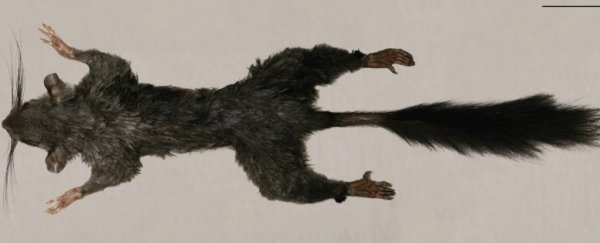Researchers are closer than ever to finding a living Zenkeralla (Zenkerella insignis) in the wild, after they discovered three recently dead specimens on Bioko Island, off the west coast of Africa.
The mysterious rodent, which looks sort of like a squirrel with a super bushy tail, has eluded researchers for years, making it one of the most mysterious mammals in the world.
"Zenkerella could be seen as the ultimate Pokémon that scientists have still not been able to find or catch alive," said team member Erik Seiffert, from the University of Southern California.
"After all, it probably only shows up in the middle of the night, deep in the jungles of central Africa, and might spend most of its time way up in tall trees where it would be particularly hard to see."
Commonly referred to as a 'living fossil', because evolution doesn't appear to have changed it all that much over the species' 49-million-year history, this incredibly elusive creature is one of the least-studied mammals on the planet.
So far, there are only 11 Zenkerella specimens in museums across the globe, not including the three newly deceased individuals found on Bioko Island.
As for live specimens, the team says the last reported sighting was two decades ago, and no one has ever managed to capture a living Zenkerella.
But researchers are now finally making some headway in their understanding of the species.
Thanks to the three new specimens, Seiffert's team was able to examine the creature's DNA for the first time. From that, they figured out that these mammals are very distant cousins of other scaly-tailed squirrels.
They also suggest that the species lacks the ability to glide, and are strange enough to warrant a separate Zenkerellidae family classification all of their own.
Even more exciting is the fact that the specimens offer the team a unique glimpse into the evolutionary past of mammals, which could provide details on how certain traits formed over time, and why some species stayed relatively the same over millions of years, while others changed dramatically.
"It's an amazing story of survival," Seiffert said. "We are only just starting to work on basic descriptions of Zenkerella's anatomy. It's fun to think that there might be other elusive mammalian species out there, deep in the rainforests of central Africa that will be new to science."
 Joseph Smit/WikiCommons
Joseph Smit/WikiCommons
The ongoing hope, of course, is to catch a Zenkerella alive.
Seiffert says the team will likely start by travelling to central Africa and Bioko Island, where local hunters reportedly find them dead in their traps about twice a month.
This suggests that there are still a few live ones scampering about in the region, but the problem is that, with so little knowledge on the species to go on, search parties wouldn't know where to look. Hopefully, with the help of the locals, a team will put the mystery to bed soon.
A poor understanding of Zenkerellas isn't just bad for researchers. According to the team, since very little is known about the creatures, they are often left off endangered or threatened species lists entirely. The International Union for Conservation of Nature (ICUN) currently lists them as of least concern.
"This rating belies the fact that threats such as habitat loss and degradation are intense and widespread in central Africa," said team member Drew Cronin, from Drexel University.
"Zenkerella may be under greater threat. The more information and visibility for the species that we can generate, the more likely we are to facilitate the research and conservation attention a unique species like Zenkerella requires."
The team's work was published in the journal PeerJ.
